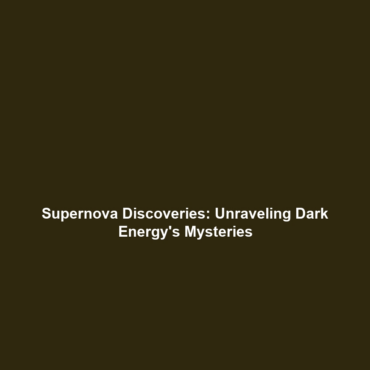Supernova Observations and Their Role in Dark Energy Discovery
Introduction
Supernova observations have played a pivotal role in the groundbreaking discovery of dark energy, fundamentally altering our understanding of the universe. Dark energy, a mysterious force driving the accelerated expansion of the cosmos, is a critical aspect of the broader study of dark matter and dark energy. By examining the light emitted by supernovae, astronomers can glean vital information about cosmic structures and the dynamics of the universe itself. This article delves into how supernova observations have transformed modern astrophysics and their significance in unraveling the mysteries surrounding dark energy.
Key Concepts
Supernovae and Their Types
Supernovae are explosive events that mark the death of stars. They are primarily classified into two types: Type I and Type II. Type Ia supernovae, which result from the thermonuclear explosion of a white dwarf, serve as crucial standard candles for measuring astronomical distances. This concept is integral to understanding the rate of the universe’s expansion, a key factor in dark energy research.
The Role of Redshift
Redshift is a vital concept that measures how light from distant galaxies stretches as the universe expands. By studying the redshift in supernova light, scientists can infer the rate of the universe’s expansion and gain insight into the influence of dark energy, thereby fitting it into the broader context of dark matter and dark energy.
Applications and Real-World Uses
The applications of supernova observations and their role in dark energy discovery extend beyond theoretical physics. Some practical uses include:
- Distance Measurement: Supernovae provide a reliable method for measuring cosmic distances, enhancing our understanding of the structure of the universe.
- Cosmological Models: Supernova data helps refine models predicting the universe’s fate, impacting fields like cosmology and astrophysics.
- Public Awareness: Supernova observations can help foster public interest in space research, encouraging educational initiatives related to STEM fields.
Current Challenges
Despite the significant contributions of supernova observations to dark energy discovery, several challenges persist:
- Data Availability: The number of observed supernovae is limited, hindering statistical analysis.
- Model Uncertainty: There are uncertainties in cosmological models that integrate supernova data.
- Technological Limitations: Current telescopes may not capture all relevant supernova events, necessitating advances in technology.
Future Research and Innovations
Future research in supernova observations is expected to yield innovations that significantly advance our understanding of dark energy. Upcoming projects, such as the Euclid satellite, aim to map the geometry of the universe with unprecedented precision. Breakthroughs in machine learning may also enhance data analysis, allowing for the identification of supernovae faster and more accurately than before, which is crucial for furthering our cosmological knowledge.
Conclusion
Supernova observations are not only essential in the context of dark energy discovery, but they also represent a key area of research within dark matter and dark energy. As technology advances and new discoveries are made, the potential for deeper insights into the fabric of our universe expands. For those interested in further exploring this fascinating subject, consider reading more about dark energy and supernova research to stay updated with the latest advances in astronomical science.

Leave a Reply